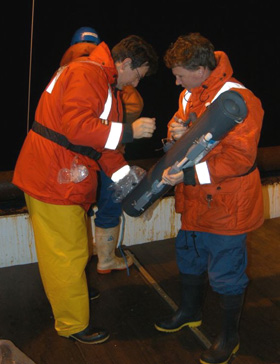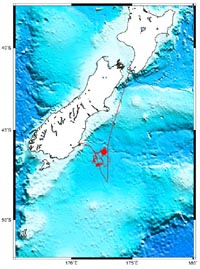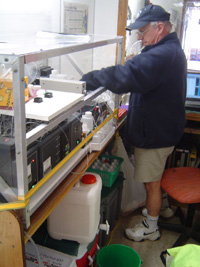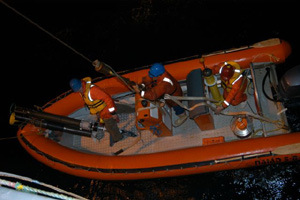Cruise
Log: Wednesday, April 7, 2004
|
March
|
|
Sun
|
Mon
|
Tue
|
Wed
|
Thu
|
Fri
|
Sat
|
|
|
1
|
2
|
3
|
4
|
5
|
6
|
|
7
|
8
|
9
|
10
|
11
|
12
|
13
|
|
14
|
15
|
16
|
17
|
18
|
19
|
|
|
|
|
|
|
|
|
|
|
|
|
|
|
|
|
|
|
April
|
|
|
|
|
|
|
|
|
|
|
|
|
7
|
|
|
|
|
|
|
|
|
|
16
|
17
|
|
18
|
19
|
20
|
21
|
22
|
23
|
24
|
|
25
|
26
|
27
|
28
|
29
|
30
|
|
|
| |
 |
| Karl
Safi and Mike Elwood deploying the Go-flow Bottles (Photo by Bill
Main). |
| |
 |
| Incubators
on the back deck (Photo by Karl Safi). |
| |
| |
| |
 |
Location
of the RV Tangaroa on April 7, 2004.
Position: 46 15. 36S 172 41. 24E |
A plankton
brew
Contributors: Karl Safi, Stuart Pickmere
It was a late night.
We had our first and probably only opportunity to run Go-flow bottles for
trace metal chemistry tonight. I was assisting Mike Elwood with this sampling,
which he estimated
would take about 3 hours but it ended up taking us around 6 hours. It all
went very successfully in the end and we managed to collect samples from
a wide range of depths. Overall today was another busy day with the setup
of a microzooplankton (small animal plankton) grazing experiment in the
morning and the processing of another microzooplankton grazing experiment
through into the afternoon. This was followed by the Go-flows after dinner.
The microzooplankton grazing experiments were experiment numbers 18 and
19 of this type and involve collecting water from the CTD casts and incubating
different treatments for 24 hours in on-deck incubators at the back of the
ship. The experiments give us an estimate of how well the small (<200
µm) grazers are controlling the phytoplankton populations within our
patch and preventing them from blooming. Unfortunately most of the analysis
of these experiments cannot be conducted on the ship and we will have to
wait until we return to port and process the numerous samples we have collected.
Fortunately however, Steve Archer who is working on DMSp, has been taking
subsamples from these experiments and his results have given us some indication
of how things have been going. The results indicate that growth rates of
phytoplankton in our patch have, as we hoped, increased but that these small
grazers (microzooplankton) have also been doing a good job of eating this
production and perhaps preventing the phytoplankton bloom we expected.
 |
| Stu
working on the nutrient analyzer (Photo by Karl Safi). |
During the day while
I was in the lab running these grazing experiments many other activities
were going on. Stu was, as usual, working throughout the day, keeping
an eye on the nutrients. It is essential that we follow the nutrient levels
to make sure they are not limiting the growth of the phytoplankton. We
are also interested in whether the phytoplankton themselves have been
using up the nutrients for growth but so far Stu has seen little evidence
of this. Stu has also been running samples from all the various incubation
experiments including my grazing experiments to make sure nutrient levels
do not become an issue in our incubations.
The sight of Naiad
going over the side in between Go-flows this evening was quite spectacular
against the pitch black of night. The weather was also good today which
always makes the job out here much easier and there was a great full moon
that made it a little more pleasant out on deck despite the bitterly cold
wind. Next Day>>
 |
| Naiad
approaching the ship after a nighttime deployment with SkinDeEP and
TRAMP located at the bow of the boat (Photo by Bill Main). |
|